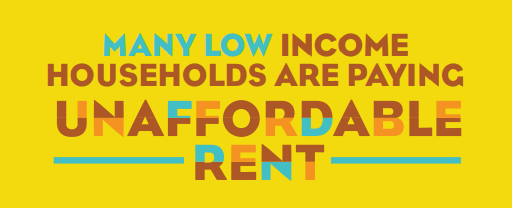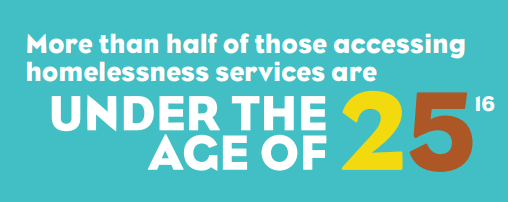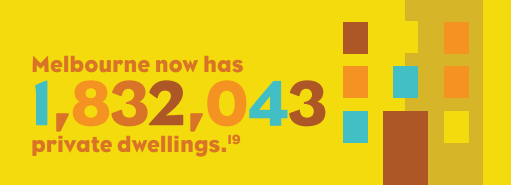The current situation
Not enough rental accommodation
There is a shortage of at least 72,200 rental homes for households that earn the bottom 40 per cent of incomes. As a result, nearly 60 per cent of low and very low income households are paying unaffordable rents–defined as more than a third of their income.4
In a rental market snapshot taken during April 2017, 0.7 per cent of private rental properties advertised in Greater Melbourne were suitable for a household living on income support payments.5
Affordable housing for households on income support payments6
| City | Affordable
Housing |
| Greater Brisbane | 12.3% |
| Greater Adelaide | 3.7% |
| Greater Perth | 3.0% |
| Greater Melbourne | 0.7% |
| Greater Sydney | 0.0% |

Across Greater Melbourne, cheaper housing is often located in areas with higher levels of crime and lower levels of access to services and employment. This can entrench disadvantage.7
 8
8
An April 2017 survey found only one property in Greater Melbourne that was affordable for a single person on Newstart Allowance.9
More people are homeless
As of 2011, approximately 23,000 people are homeless, and stay in temporary crisis accommodation, sleep in cars, or ‘couch surf’ at family or friends’ homes.10
It is estimated that five per cent of Victoria’s homeless are ‘rough sleepers’, sleeping on the streets or improvised dwellings such as tents or site sheds.11
The number of improvised dwellings increased 31 per cent across Greater Melbourne between 2011 and 2016, compared to five per cent in regional Victoria.12
Nearly 40 per cent of all improvised housing in Greater Melbourne is located within the City of Melbourne, and this increased more than 175 per cent between 2011 and 2016.13
In the past three years, Melbourne has lost 460 rooms in crisis accommodation.14 This further limits the options available to
people at risk of homelessness.
Older women are at particular risk of homelessness. Consequences stemming from relationship breakdown, family violence or illness, the high cost of housing, lower superannuation or income from casual work, the gender pay gap and unpaid carer roles can result in housing instability.15
Since 2012, the number of older women who are ‘couch surfing’ has increased by 83 per cent. There has also been a 75 per cent increase in older women sleeping in their cars presenting at homelessness services.16
 17
17
More social housing needed
Despite growing demand, the stock of public and community housing continues to decline as a proportion of all housing in Victoria. Public and community housing accounts for three per cent of all dwellings, down from four per cent in 2006.18
New types of development
Suburban subdivision in Melbourne’s growth corridors has continued at a relatively constant pace since 2001. More than 195,000 new dwellings were added to Greater Melbourne’s stock between 2011 and 2016.19

Most new apartment development has occurred within the inner suburbs. The biggest increase in new dwellings however has occurred in the outer regions of Greater Melbourne. The creation of standalone housing in Melbourne’s outer suburbs accounted for 30 per cent of new dwellings.20
 21
21
The number of new townhouses in Greater Melbourne increased by 60 per cent in the five years leading up to 2016.22
Number of Dwellings in Greater Melbourne23
| | Dwellings
(2011) | Dwellings
(2016) |
| Separate House | 1,039,342 | 1,067,637 |
| Semi-Detached House | 165,486 | 264,409 |
| Flat/Apartment | 219,111 | 231,297 |
| Other* | 6,159 | 6,400 |
*Includes caravans, houseboats, dwelling attached to a flat or office and improvised homes.
New homes replacing farmland
New residential developments in the city’s outer regions are replacing farmland and habitat. This impacts on Melbourne’s capacity to produce food and the environmental sustainability of the metropolitan region.24
References
1 CoreLogic, “Housing Affordability Report,” December 2016. [Online]. Available: https://www.corelogic.com.au/reports/CL_Housing-Affordability-Dec_2016.pdf
2 C. Cashmore, “Speculative Vacancies 8,” 2015. [Online]. Available: https://www.prosper.org.au/wp-content/uploads/2015/12/11Final_Speculative-Vacancies-2015-1.pdf
3 CoreLogic, “Housing Affordability Report,” December 2016. [Online]. Available: https://www.corelogic.com.au/reports/CL_Housing-Affordability-Dec_2016.pdf
4 K. Hulse, M. Reynolds, W. Stone and J. Yates, “Supply Shortages and Affordability Outcomes in the Private Rental Sector: Short and Longer Term Trends,” 9 June 2015. [Online]. Available: http://www. ahuri.edu.au/research/final-reports/241
5 Anglicare Australia, “Rental Affordability Snapshot,” April 2017. [Online]. Available: http://www.anglicare.asn.au/docs/default-source/ default-document-library/anglicare-australia-ras-2017---reissue-final.pdf?sfvrsn=0
6 Anglicare Australia, “Rental Affordability Snapshot,” April 2017. [Online]. Available: http://www.anglicare.asn.au/docs/default-source/ default-document-library/anglicare-australia-ras-2017---reissue-final.pdf?sfvrsn=0
7 Anglicare Australia, “Rental Affordability Snapshot,” April 2017. [Online]. Available: http://www.anglicare.asn.au/docs/default-source/ default-document-library/anglicare-australia-ras-2017---reissue-final.pdf?sfvrsn=0
8 K. Hulse, M. Reynolds, W. Stone and J. Yates, “Supply Shortages and Affordability Outcomes in the Private Rental Sector: Short and Longer Term Trends,” 9 June 2015. [Online]. Available: http://www. ahuri.edu.au/research/final-reports/241
9 Anglicare Australia, “Rental Affordability Snapshot,” April 2017. [Online]. Available: http://www.anglicare.asn.au/docs/default-source/ default-document-library/anglicare-australia-ras-2017---reissue-final.pdf?sfvrsn=0
10 Homelessness Australia, “Homelessness in Victoria,” [Online]. Available: http://www.homelessnessaustralia.org.au/images/publications/Infographics/state_sheets_VIC.pdf
11 Homelessness Australia, “Homelessness in Victoria,” [Online]. Available: http://www.homelessnessaustralia.org.au/images/publications/Infographics/state_sheets_VIC.pdf
12 Australian Bureau of Statistics, “TableBuilder 2011 Census - Dwelling Characteristics,” 26 June 2017. [Online]. Available: http://www. abs.gov.au/websitedbs/D3310114.nsf/Home/2016%20TableBuilder
13 Australian Bureau of Statistics, “TableBuilder 2016 Census - Selected Dwellings Characteristics,” 27 June 2017. [Online]. Available: http://www.abs.gov.au/websitedbs/D3310114.nsf/Home/2016%20 TableBuilder
14 E. Witte, “The Case for Investing in Last Resort Housing,” Melbourne Sustainable Society Institute Issues Paper No.10, The University of Melbourne, 2017.
15 S. Darab and Y. Hartman, “Understanding Single Older Women’s Invisibility in Housing Issues in Australia,” Housing, Theory and Society, vol. 30, no. 4, pp. 348-367, 2013.
16 Council to Homeless Persons, “Hidden Homelessness on the Rise,” 7 August 2017. [Online]. Available: http://chp.org.au/wp-content/ uploads/2017/08/170807-rapid-rise-in-hidden-forms-of-homelessness-HW2017.pdf
17 Council to Homeless Persons, “Homelessness in Victoria,” 2012. [Online]. Available: http://chp.org.au/wp-content/uploads/2012/12/10122012_Homelessness-in-Victoria-with-2011- ABS-stats.pdf
18 Victorian Auditor General, “Managing Victoria’s Public Housing,” June 2017. [Online]. Available: https://www.audit.vic.gov.au/sites/ default/files/20170621-Public-Housing.pdf
19 Australian Bureau of Statistics, “2011 Census QuickStats,” 28 March 2013. [Online]. Available: http://www.censusdata.abs.gov.au/ census_services/getproduct/census/2011/quickstat/2GMEL?opendocument&navpos=220
Australian Bureau of Statistics, “2016 Census Quick Stats,” 27 June 2017. [Online]. Available: http://www.censusdata.abs.gov.au/ census_services/getproduct/census/2016/quickstat/2GMEL?opendocument
20 Australian Bureau of Statistics, “TableBuilder 2011 Census - Dwelling Characteristics,” 26 June 2017. [Online]. Available: http://www. abs.gov.au/websitedbs/D3310114.nsf/Home/2016%20TableBuilder
21 Australian Bureau of Statistics, “2016 Census Quick Stats,” 27 June 2017. [Online]. Available: http://www.censusdata.abs.gov.au/ census_services/getproduct/census/2016/quickstat/2GMEL?opendocument
22 Australian Bureau of Statistics, “2011 Census QuickStats,” 28 March 2013. [Online]. Available: http://www.censusdata.abs.gov.au/ census_services/getproduct/census/2011/quickstat/2GMEL?opendocument&navpos=220
Australian Bureau of Statistics, “2016 Census Quick Stats,” 27 June 2017. [Online]. Available: http://www.censusdata.abs.gov.au/ census_services/getproduct/census/2016/quickstat/2GMEL?opendocument
23 R. Carey, K. Larsen and J. Sheridan, “Melbourne’s Food Future: Planning a Resilient City Foodbowl,” 2016. [Online]. Available: http:// veil.msd.unimelb.edu.au/__data/assets/pdf_file/0010/2355148/ Foodprint-Melbourne-summary-briefing.pdf